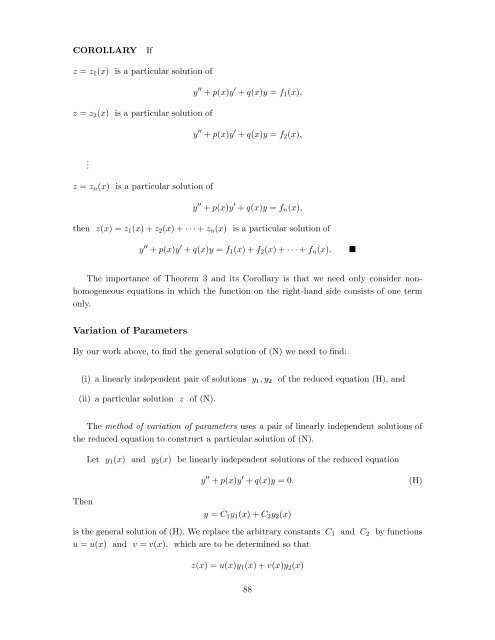Second Order Linear Differential Equations
Second Order Linear Differential Equations
Second Order Linear Differential Equations
You also want an ePaper? Increase the reach of your titles
YUMPU automatically turns print PDFs into web optimized ePapers that Google loves.
COROLLARY If<br />
z = z1(x) is a particular solution of<br />
z = z2(x) is a particular solution of<br />
.<br />
z = zn(x) is a particular solution of<br />
y ′′ + p(x)y ′ + q(x)y = f1(x),<br />
y ′′ + p(x)y ′ + q(x)y = f2(x),<br />
y ′′ + p(x)y ′ + q(x)y = fn(x),<br />
then z(x) =z1(x)+z2(x)+···+ zn(x) is a particular solution of<br />
y ′′ + p(x)y ′ + q(x)y = f1(x)+f2(x)+···+ fn(x). <br />
The importance of Theorem 3 and its Corollary is that we need only consider nonhomogeneous<br />
equations in which the function on the right-hand side consists of one term<br />
only.<br />
Variation of Parameters<br />
By our work above, to find the general solution of (N) we need to find:<br />
(i) a linearly independent pair of solutions y1,y2 of the reduced equation (H), and<br />
(ii) a particular solution z of (N).<br />
The method of variation of parameters uses a pair of linearly independent solutions of<br />
the reduced equation to construct a particular solution of (N).<br />
Then<br />
Let y1(x) and y2(x) be linearly independent solutions of the reduced equation<br />
y ′′ + p(x)y ′ + q(x)y =0. (H)<br />
y = C1y1(x)+C2y2(x)<br />
is the general solution of (H). We replace the arbitrary constants C1 and C2 by functions<br />
u = u(x) and v = v(x), which are to be determined so that<br />
z(x) =u(x)y1(x)+v(x)y2(x)<br />
88

















